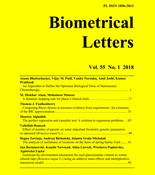
Biometrical Letters Vol. 55(1), 2018, pp. 61-84


The purpose of breeding experiments is to predict the best yielding lines to be registered. Unfortunately, the results obtained in different locations and years are often different. The main objective of this study was the evaluation and choice of experimental locations. The methods used included ANOVA, Andrews’ curves, PCA, cluster analysis, coefficients of usefulness and heritability coefficients. The experimental data are derived from pre-preliminary and preliminary breeding experiments with spring barley (Hordeum vulgare L.), malting and fodder, conducted in the period from 2008 to 2013 at six experimental stations in Poland. The results showed that some of the locations were similar in respect of the analyzed coefficients, while some locations were unique. The most valuable locations were indicated as those which have the greatest contribution to the interaction and the greatest usefulness (the lowest joint usefulness coefficient). This is because, at the last stage of new variety cultivation, when new varieties are to be registered, they are evaluated in more variable experimental environments.

Andrews’ curves, breeding trials, new genotypes, multivariate analysis, PCA.

